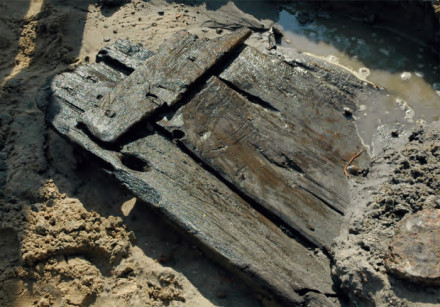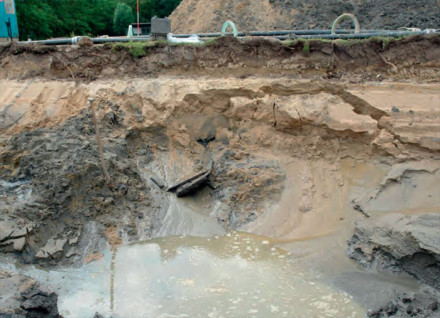History
Medieval shipwreck find
In 2010, during preparations for the construction of a new canal, parts of a medieval quay were found near Vleuten in the municipality of Utrecht (the Netherlands). Further research was ordered by the municipality which turned up a cluster of finds pointing to a medieval village and harbour with a maritime commercial status. Nails and wooden ship fragments have been found on the site. One of these finds was an iron clench nail, which hint to a Nordic clinker-built shipbuilding tradition. It is possible that some of these ship parts were reused in the construction of the harbour.
Remains of a very early ship were also found. This wreck was named the Vleuten 1. It turned out to be the earliest wreck of the Utrecht ship type ship found so far. Wrecks from the early middle ages (AD 500-800) are extremely rare. In the Utrecht area several shipwrecks from the Roman period and medieval period have been found (see for instance Meern 1 to 3). The Vleuten 1 wreck lies near a silted up branch of the river Rhine. It was constructed without the used of iron nails. Using dendrochronology, wood from the wreck was dated to 734 AD (plus or minus 7 years). Thus, the Vleuten 1 is dated to a period of great economic prosperity for the region, after the Franks conquered Frisia and before the Viking raids.

Historical context
The area (part of the estuary region of the Rhine) in which the Vleuten 1 was found, was a very important economic region in (early) medieval times. The city of Utrecht was very near and an old Roman fortress lay within sight of the Vleuten 1 location.
From 600 AD onward the Franks conquered this region and established strongholds on the locations of the old Roman fortresses guarding the former Limes (the border of the Roman Empire, near the cities of Nijmegen, Wijk bij Duurstede and Utrecht). The area became the border between the pagan North Sea cultures (the Frisians and Saxons) and the Christian Franks. Focus point of Frankish wealth and power was the city of Dorestad. The city already had it own mint before 640 AD. Sources speak of a prosperous city with big churches, and rich inhabitants who were not very friendly to strangers. It seems that Dorestad was one of the biggest cities in Northern Europe, with 2000 to 3000 inhabitants in its heyday.
The Franks used Christianity as a tool to get a political grip on the Low Countries. Archbishop Willibrord was allowed to established a church in Utrecht, which became the centre of conversion for the Frisians and Saxons. Although the Frisian king Radbod briefly reconquered the area in 712 it became a part of the Frankish empire again in 719. The Frisian lands were conquered definitely by the Franks in 734.

Description
Width: ca. 1.5 m.


Status
After the assessment, the Vleuten 1 was preserved in situ.

References
- Manders, M. Hoegen R (2011).
RAM 198, Waardestelling Vleuten 1.
RCE. - Gemeente Utrecht.
Twee schepen en een kade uit de vroege middeleeuwen. - Wynia, H. (2015) Pompeii aan de Rijn, bijzondere Utrechtse scheepsvondsten in: Oud Utrecht 88.
- Brouwers, Jansma, Manders (2015 in press) Middeleeuwse scheepsresten in Nederland in Archeobrief 2015, 3.
- Digitaal Collaboratorium voor Culturele Dendrochronologie (DCCD).